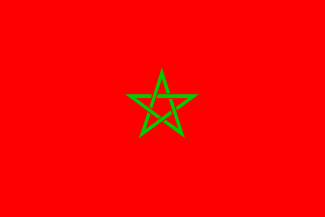Saturday 7 April 2007
It is a very bright morning. We
have breakfast in the dining room on the rooftop.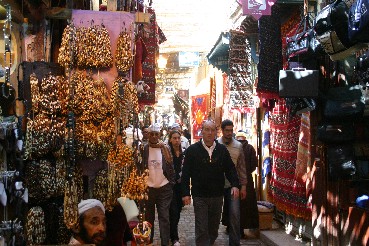 Breakfast is simple and consists of bread, jam and some other spreads. We asked
the hotel to arrange a guide to show us the old town of Fes today. The guide
meets us at 9.15. He first takes us in our own car to a lookout near an old
fortress (Borj Sud) in the hills. The view of the city if magnificent. We can
see all the major buidlings like the tomb of Idriss II and the Kairaouine mosque
and university. We drive on to a pottery (Serghini) near the Bab (gate) Ftouh,
where we get a tour of the workshops and end up in the shop of course. The
ceramics are traditional Moroccan and look very nice.
Breakfast is simple and consists of bread, jam and some other spreads. We asked
the hotel to arrange a guide to show us the old town of Fes today. The guide
meets us at 9.15. He first takes us in our own car to a lookout near an old
fortress (Borj Sud) in the hills. The view of the city if magnificent. We can
see all the major buidlings like the tomb of Idriss II and the Kairaouine mosque
and university. We drive on to a pottery (Serghini) near the Bab (gate) Ftouh,
where we get a tour of the workshops and end up in the shop of course. The
ceramics are traditional Moroccan and look very nice.
Next we drive to the Medina of Fes el Bali. We
park the car and carry on on foot trying to keep up with the extremely high pace
of our guide. He takes us through numerous busy soukhs, where you can buy
anything thinkable. Chicken (alive), meat, cloth (we visit a loom), timberwork,
copper, djellaba's, carpets etc. The guide takes on a lot of visits to
shops and artisans and each time we try to decline the offer of tea in order to
avoid a purchase. In the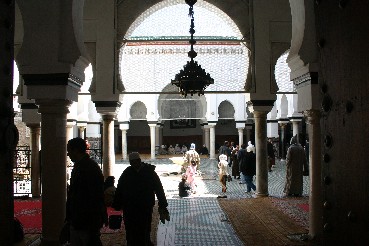 carpet shop we can go up the roof for look at the old town. At a weaving
mill we buy a long scarf which will come in handy on our coming visit to the
desert. The one armed sales guy shows us how put it on. We pass a couple of
mosques: Kairouine mosque (unfortunately closed now for repairs;
until 1993 the largest mosque in the country and one of the oldest universities
in the world. Older than Oxford and Bologna, our guide tells us), next to it the
Attarin
Medersa (Koran school, also closed), the Zaouia of Moulay Idriss II.
This is just like that of Idriss I (his father), which we saw a day earlier in
the village of Mulay
Idriss, a place of pilgrimage
carpet shop we can go up the roof for look at the old town. At a weaving
mill we buy a long scarf which will come in handy on our coming visit to the
desert. The one armed sales guy shows us how put it on. We pass a couple of
mosques: Kairouine mosque (unfortunately closed now for repairs;
until 1993 the largest mosque in the country and one of the oldest universities
in the world. Older than Oxford and Bologna, our guide tells us), next to it the
Attarin
Medersa (Koran school, also closed), the Zaouia of Moulay Idriss II.
This is just like that of Idriss I (his father), which we saw a day earlier in
the village of Mulay
Idriss, a place of pilgrimage . We
can peek into it, but are not allowed to enter this holy place. It is off limits
for non-Muslims. . We
can peek into it, but are not allowed to enter this holy place. It is off limits
for non-Muslims.
Neijarin souk is the
place to find carpenters. Nearby on the Neijarin square is the Neijarin
Fondouk, once in the 18th century a gathering place traders in carpentry. It
now houses the wood carving museum. An impressive building in its own
right. We have a cup of mint tea on the square in order to slow down a
bit. The guide's pace is very high. The streets are intimidatingly busy and we
can barely take it all in. Most spectacular sight is the tannery. In
large tubs the tanners treat and colour the skins of sheep, goats and dromedaries.
We look at the spectacle from the roof top of a leather shop. The pervasive
smell is a bit off putting, but we get a few mint leaves to fight it. In the
15th century Fes to Cordoba's place (southern Spain) as the major centre for
leather. Nothing seem to have changed here since then. 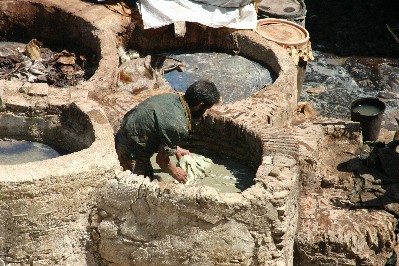 The tanners are up to their waist in dye and pigeon dung (used to treat the
leather). Our guide stresses that the dyes are natural and not harmful. From
other sources we learn that most dyes are synthetic and possible cause
cancer. Back down again we are expected to visit the shop, we ignore the
calls of the sales attendants, much to the distress of the owner who confronts
our guide. We get away with it. .
The tanners are up to their waist in dye and pigeon dung (used to treat the
leather). Our guide stresses that the dyes are natural and not harmful. From
other sources we learn that most dyes are synthetic and possible cause
cancer. Back down again we are expected to visit the shop, we ignore the
calls of the sales attendants, much to the distress of the owner who confronts
our guide. We get away with it. .
We walk to the jewelers' soukh.
The soukh burnt down in 1999 and has been rebuilt. We conclude the tour in a
restaurant, picked out by our guide. The guide leaves us here. It is a fine
restaurant, where we get a delicious 3 course lunch. The elaborate Moroccan
salad consists of 12 small plates with different tastings. It is followed by a
lamb skewer and tea and biscuits by way of desert.
All in al we were not quite
content with our guide. The pace was killing, although it got better when we
stopped following his pace and let him adapt to ours. We visited way too many
shops and artisans where we felt embarrassed to decline numerous offers of tea
and goods.  We did see some sights, but not many in comparison to the number of shops. We
did confront the guide about it but it did quite work out the way we wanted. He
was more concerned with his commissions.
We did see some sights, but not many in comparison to the number of shops. We
did confront the guide about it but it did quite work out the way we wanted. He
was more concerned with his commissions.
After lunch we drive the car
back to the hotel, the Riad Louna. We spend the afternoon on the roof terrace
and later we visit the Medersa Bou Inania. A medersa is an old Koran school, or
more accurately said a boarding house for Koran students. There is a prayer
going on and we have to wait a while before we can enter. The building dates
back to the Merinid period in the 14th century. It is one of the finest of
its kind in Fes. Beautiful tiles and wood carvings decorate the building with
its simple lay out., consisting of a courtyard with a gallery around it. The are
student cells on two levels in which the students used to study and sleep. A
loggia like niche functions as a prayer hall.
After the visit we walk to the
main square between Fes el Bali and Fes el Djedid. Here we see all kind of
things going on, from monkey abuse (they let children fight with a chained
monkey), to story tellers, gambling, jugglers, medicine men and everything else
you might expect on a medieval fair ground.
At night we have a simple
dinner at the Kasbah de Fes, a simple restaurant, but superbly set on two
floors close to the blue Bab Boujeloud. Later we drinken coffee at a side
walk café just outside the gate, not far from our Riad. We cannot fail to
notice the sheer absence of women. All customers in the café's are male, except
for the odd tourist. In Casablanca and Rabat street life was more mixed. As the
night wears on it becomes colder and we could do with a pullover. After a while
it becomes too cold we go back to our room to have a beer. Alcohol is not served
outdoors.
Weather: sunny, warm 22°C/72°F.
At night it cools off to 12°C/54°F.
Sunday
8 April 2007
After breakfast we settle the
bill and head south. Via the Ville Nouvelle we leave town. We fill up the tank
in one of the suburbs and ask for directions. Signposting is not really up to
standards here in Fes. After a while the roads become quieter. After 40km (25mi) we reach the town of Ifrane It
is a ski resort and since 1995 it also has a university. It resembles a French
Alpine town, which is not strange baring in mind it was founded by the French in
1929. Recently it saw the addition of Royal residence. The road down south runs
past it. Suddenly we see groups of people on the way side looking at the trees.
A large group of Barbary Apes is showing off at the edge of a forest. We step
out of the car for pictures. South of Ifrane we make a left turn and follow a
very quiet road. The road climbs higher and we see patches of snow here and
there. The views on the higher plain magnificent. We hardly see a soul. There
are some huts in the distance and we see the occasional shepherd with his flock.
After a while we turn right towards Boulemane. In Boulemane
while the roads become quieter. After 40km (25mi) we reach the town of Ifrane It
is a ski resort and since 1995 it also has a university. It resembles a French
Alpine town, which is not strange baring in mind it was founded by the French in
1929. Recently it saw the addition of Royal residence. The road down south runs
past it. Suddenly we see groups of people on the way side looking at the trees.
A large group of Barbary Apes is showing off at the edge of a forest. We step
out of the car for pictures. South of Ifrane we make a left turn and follow a
very quiet road. The road climbs higher and we see patches of snow here and
there. The views on the higher plain magnificent. We hardly see a soul. There
are some huts in the distance and we see the occasional shepherd with his flock.
After a while we turn right towards Boulemane. In Boulemane we have lunch in a very simple eatery. Minced meat is grilled for us outside on
charcoal barbecue. Including the french fries and the cokes it adds up to 60 dh (~€5,50)
for the both of us. We continue and arrive in Midelt around 2pm. This is
a simple town, be it bigger than most places we have seen today. There is a bus
station and a souhk. We have made a reservation by phone at
hotel Kasbah Asmaa about two km (1¼mi) out of town. It is built in some fake
kasbah style and has a large pool. Tour busses stop here for lunch. We have a
spacious room with a view on the pool and the snow capped mountains of the
Middle Atlas. In the afternoon we drive out to town. We drink mint tea and visit
the soukh. There are loads of Berber carpets for sale. Erik has his hair cut at
a tiny barber shop. After that we drive to the carpet workshop of the Franciscan
sisters. The nuns teach the town girls to read, write and calculate and learn
how to knot carpets and embroider table cloths. The workshop is closed on a
Sunday, the students have a day off. We are shown around and have a look at the
nice carpets and and the Moroccan style embroideries (no knots, no reverse
side). We go back to the hotel for cocktails and dinner. The food is ok,
but nothing special.
we have lunch in a very simple eatery. Minced meat is grilled for us outside on
charcoal barbecue. Including the french fries and the cokes it adds up to 60 dh (~€5,50)
for the both of us. We continue and arrive in Midelt around 2pm. This is
a simple town, be it bigger than most places we have seen today. There is a bus
station and a souhk. We have made a reservation by phone at
hotel Kasbah Asmaa about two km (1¼mi) out of town. It is built in some fake
kasbah style and has a large pool. Tour busses stop here for lunch. We have a
spacious room with a view on the pool and the snow capped mountains of the
Middle Atlas. In the afternoon we drive out to town. We drink mint tea and visit
the soukh. There are loads of Berber carpets for sale. Erik has his hair cut at
a tiny barber shop. After that we drive to the carpet workshop of the Franciscan
sisters. The nuns teach the town girls to read, write and calculate and learn
how to knot carpets and embroider table cloths. The workshop is closed on a
Sunday, the students have a day off. We are shown around and have a look at the
nice carpets and and the Moroccan style embroideries (no knots, no reverse
side). We go back to the hotel for cocktails and dinner. The food is ok,
but nothing special.
Weather: sunny, around
20°C/68°F; evening 12°C/54°F.
Monday 9 April 2007
After breakfast in the Red Room
we leave Midelt at 8am. The roads leads us into the mountains. Numerous hairpin
curves lead us through the Middle Atlas. The passes are beautiful and the roads very quiet. Here and there a stream meanders through the gorges. When we are
over the mountains the terrain becomes barren and flat. The barrenness of
the landscape is sometimes interrupted by oases and palmeries. We first
reach Er Rachidia, after some 125km (78mi). It is a reasonably large town,
priding itself for having a university. The town is followed by yet another
barren plain with oases and small villages. In the villages people walk on the
road oblivious of motorized traffic. Driving with care is important. After we
set our course for Erfoud. That turns out to be a small town, be it very busy.
Traffic is chaotic with lots of cyclists and mopeds. Until a few years ago it
was the base for explorations into the dessert. The road south to Merzouga had
not been built then. Now the road is finished the importance of Erfoud is
diminished. We fill up ourt tank before driving into the dessert. Right after
leaving Erfoud we get caught up in a desert storm
very quiet. Here and there a stream meanders through the gorges. When we are
over the mountains the terrain becomes barren and flat. The barrenness of
the landscape is sometimes interrupted by oases and palmeries. We first
reach Er Rachidia, after some 125km (78mi). It is a reasonably large town,
priding itself for having a university. The town is followed by yet another
barren plain with oases and small villages. In the villages people walk on the
road oblivious of motorized traffic. Driving with care is important. After we
set our course for Erfoud. That turns out to be a small town, be it very busy.
Traffic is chaotic with lots of cyclists and mopeds. Until a few years ago it
was the base for explorations into the dessert. The road south to Merzouga had
not been built then. Now the road is finished the importance of Erfoud is
diminished. We fill up ourt tank before driving into the dessert. Right after
leaving Erfoud we get caught up in a desert storm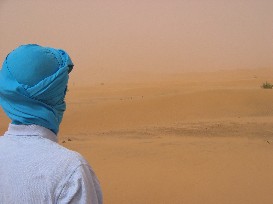 .
The sand clouds the view. After 40 km or so we reach Risani. We have been
warned that the signing towards Merzouga has been removed or erased and that
hordes of faux guides lie in wait telling stories that the Merzouga road
does not exist, it has been closed or is difficult to find and that they want to
guide you to a hotel (owned by friends or relatives of course). It turns
out not to be half as bad. Rissani is a busy town with lots of cyclists and an
army garisson. The sign for Merzouga is in tact and we do not see a single faux guide! We
meander through the palmeries into the desert. The Merzouga road runs parallel
to the sand dunes of Erg Chebbi and every two kilometres there is a
turn off towards hotels at the foot of the sand sea. After 32km we reach the
left turn towards Kasbah
Mohayut, where have booked a room. It turns out to be a fine place, kasbah
style built with mud and straw around a patio with a poo. After checking
into our very colourful room we drive to Merzouga village. It is bit of lost
place, living for tourism only. Right now there is not a lot going on, every one
seems to be on tour. As soon as we drive on to the main street we are welcomed
by a posse of would be guides and entrepreneurs offering all kinds of services. We
only want lunch. That is possible: we settle down in one of the café's
suggested by the welcoming posse. When we order, the owner has to go out
shopping for the ingredients, so it takes a while before we have our lamb skewer
and omelette on our table. We eat inside, because the wind is picking up
and we do not like to be sandblasted while we are eating. A lad sits down at our
table and tries to sell us a desert tour on camel back or by 4x4 jeep. After a
while he leaves After lunch we drive back to the hotel. The desert storm
gains strength and it gets misty. The afternoon we spend leasurely at the hotel
. At night we eat at the hotel. Local specialty is a tajine with beef and
egg. .
The sand clouds the view. After 40 km or so we reach Risani. We have been
warned that the signing towards Merzouga has been removed or erased and that
hordes of faux guides lie in wait telling stories that the Merzouga road
does not exist, it has been closed or is difficult to find and that they want to
guide you to a hotel (owned by friends or relatives of course). It turns
out not to be half as bad. Rissani is a busy town with lots of cyclists and an
army garisson. The sign for Merzouga is in tact and we do not see a single faux guide! We
meander through the palmeries into the desert. The Merzouga road runs parallel
to the sand dunes of Erg Chebbi and every two kilometres there is a
turn off towards hotels at the foot of the sand sea. After 32km we reach the
left turn towards Kasbah
Mohayut, where have booked a room. It turns out to be a fine place, kasbah
style built with mud and straw around a patio with a poo. After checking
into our very colourful room we drive to Merzouga village. It is bit of lost
place, living for tourism only. Right now there is not a lot going on, every one
seems to be on tour. As soon as we drive on to the main street we are welcomed
by a posse of would be guides and entrepreneurs offering all kinds of services. We
only want lunch. That is possible: we settle down in one of the café's
suggested by the welcoming posse. When we order, the owner has to go out
shopping for the ingredients, so it takes a while before we have our lamb skewer
and omelette on our table. We eat inside, because the wind is picking up
and we do not like to be sandblasted while we are eating. A lad sits down at our
table and tries to sell us a desert tour on camel back or by 4x4 jeep. After a
while he leaves After lunch we drive back to the hotel. The desert storm
gains strength and it gets misty. The afternoon we spend leasurely at the hotel
. At night we eat at the hotel. Local specialty is a tajine with beef and
egg.
Weather: sunny 25°C/77°F.
|
